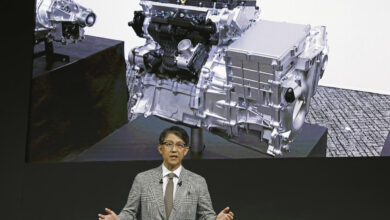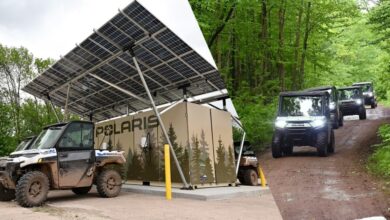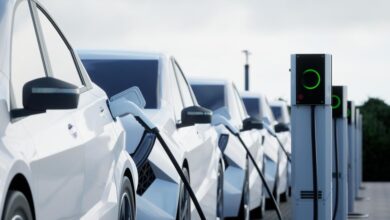No, the electric vehicle market isn’t crashing. It just needs recharging. – LocalNews8.com

By Peter Valdes-Dapena, CNN
New York (CNN) — When pondering what’s really happening with the auto industry’s shift to electric vehicles, it’s important to remember that two things – two very different things – can be true at the same time.
The first is that electric vehicle sales are continuing to rise, and will reach record levels this year. The second is the rate of EV sales growth is slowing, at least temporarily. That means those record highs won’t be as high as they would have been had sales growth continued at the same high rate as it had in, say, 2023. The EV market is not collapsing, experts say, it’s just entering a new phase.
Worldwide sales of plug-in vehicles will rise a little more than 20% this year compared to last year, according to a recent report from the International Energy Agency. That’s a significant rise but still less than the 35% global increase between 2022 and 2023.
For now, the demands of well-off, tech-savvy “early adopters,” the sort of customers who bolstered Tesla’s rise, have largely been sated. The EV industry is now in the difficult phase of “crossing the chasm” from early adopters to mass market consumers.
“The consumers who could be potentially interested in buying one in the first place, they are more likely to have already bought an EV themselves,” said Coco Zhang, an analyst with ING, in an interview with CNN. “So now, the challenge comes to unlocking the second wave of consumer adoption in those advanced economies.”
New customers, those who just want a good car and don’t care so much how it’s powered, are clearly demanding more affordable EVs. Automakers now have to find ways to please those customers, while not putting themselves out of business in the process.
Tesla’s role in slowdown
Tesla itself is a major reason for the slow-down in EVs, especially in the US. Teslas still make up slightly more than half of all the electric vehicles sold in America, according to a report from Cox Automotive. But, just one year ago, Tesla produced more than 60% of all the EVs sold America. In the first quarter of this year, Tesla sold fewer EVs in America than it did during the same quarter a year earlier, taking its share of the EV market down to around 50%.
And it has slashed prices to try staunch the losses.
At the same time, though, a number of long-established automakers grew their own electric car sales by 50% or more in the first quarter of this year in the US compared to the same quarter last year, according to Cox.
Ford, for one, was the second biggest seller of EVs in the US last year, after Tesla. Lowering the price of the popular Mustang Mach-E just 17% helped Ford more than double sales of that model.
But Ford itself ended up paying a big price. Ford’s electric vehicle endeavor is still producing big losses, and cutting prices certainly doesn’t help raise profits. Ford will postpone future electric products, as a result, while its engineers work on cheaper EV designs that it can make profitably at the lower prices customers want.
If Ford waits too long, though, its neighbor and rival, General Motors, could gain a healthy head start. After having trouble cranking up production of its new generation of electric vehicles, GM seems to be accelerating. The Cadillac Lyriq is selling well – first quarter sales this year up more than 50% as it outsold European luxury EVs – and production has restarted for the Blazer EV after an earlier stoppage. The less expensive Equinox EV is about to hit the market, too.
The China problem
Of course, one country, China, is making products that could meet thedemand for affordable EVs. But automakers in both Europe and the United States – the other two parts of the world with substantial EV markets – are wary of what an influx of Chinese EVs could do to their own industries.Chinese-made EVs are expected to account for 25% of all electric vehicles sold in Europe this year, according to the European Federation for Transport and Environment. Chinese-made EVs are entering the US market, too, through brands like Polestar and Volvo, owned by China’s Geely.
The Inflation Reduction Act, which provides tax breaks for EV buyers in the US, is geared to support domestic production of electric vehicles and, specifically, steer automakers away from vehicles and even EV components made in China. The tax credits are reduced, or could even be eliminated, based on where EVs and their battery packs and other parts are produced.
Meanwhile, in China itself, the battle for customers has become a brutal melee. Even with a market so vast – nearly 10 million EVs are expected to be sold in China this year – there are simply too many EV manufacturers competing to survive. In just the past year, more than a dozen have gone down, according to statistics from the China Passenger Car Association. The consolidation and bankruptcy process is expected to continue.
It will happen in the American market, too, although on a smaller scale.
“If you study technology disruptions and transitions, this is to be expected, this is the playbook,” said Michael Lenox, a professor of business administration at the University of Virginia who studies the EV industry. “This is exactly what you expect to happen, a massive entry and a shakeout associated with it. Some of the legacy companies will fail, some of the entrepreneurial companies will succeed, though many of the startup companies will fail as well.”
Growth on the horizon
Sales and market demand could start to look better next year for a couple of reasons, said Corey Cantor, an industry analyst with Bloomberg New Energy Finance. For one thing, governments in Europe have started paring back some incentives this year but emissions regulations will become somewhat stricter next year. Similar dynamics are emerging in the US market.
Automakers may want to push some of their EV sales into next year when they could use them to push down their average fuel economy numbers to meet those stricter standards, Cantor said.
And the industry-wide shift to the Tesla charging standard will simplify some of the hurdles to EV adoption, including a lack of chargers and the needless complexity of charging, Cantor said.
Most importantly, a number of new models, including more affordable vehicles, will arrive later this year or next year. Vehicles like a new Chevrolet Bolt EV and an electric Dodge Charger could inject some new excitement.
“If you look at automakers, where they’re planning their kind of big EV bumps, or new EV models, a lot of it’s in ’25,” Cantor said.
The-CNN-Wire
™ & © 2024 Cable News Network, Inc., a Warner Bros. Discovery Company. All rights reserved.



